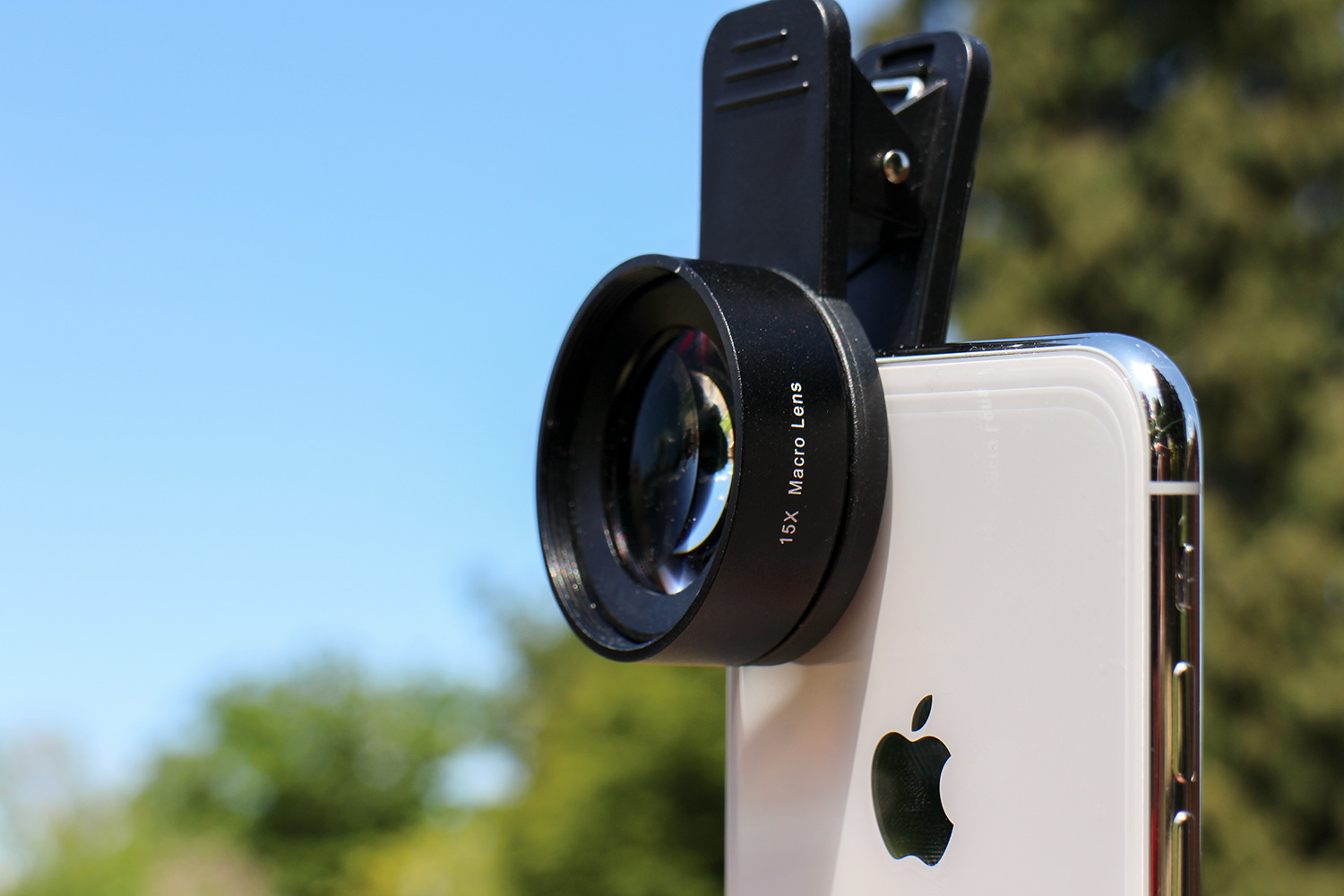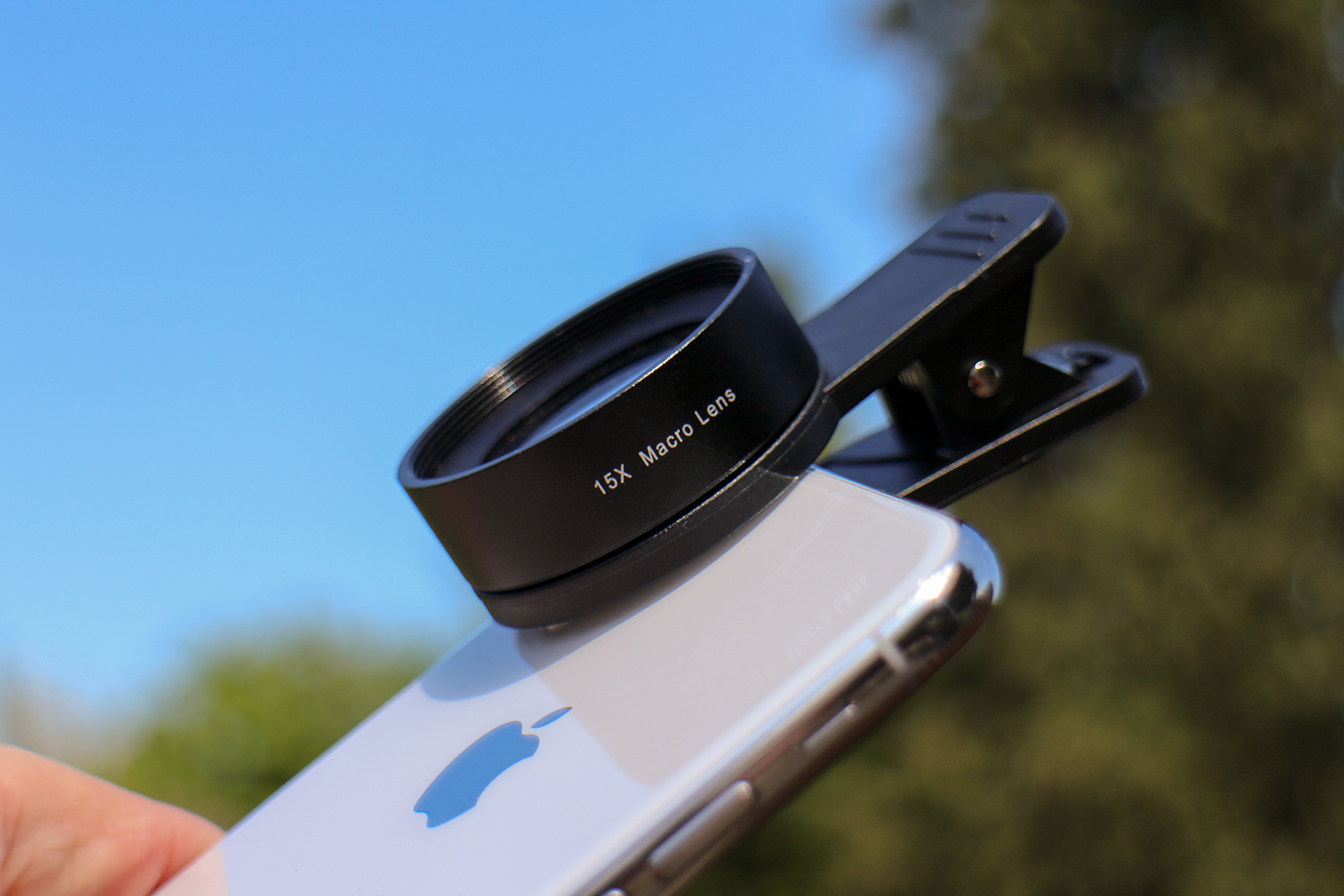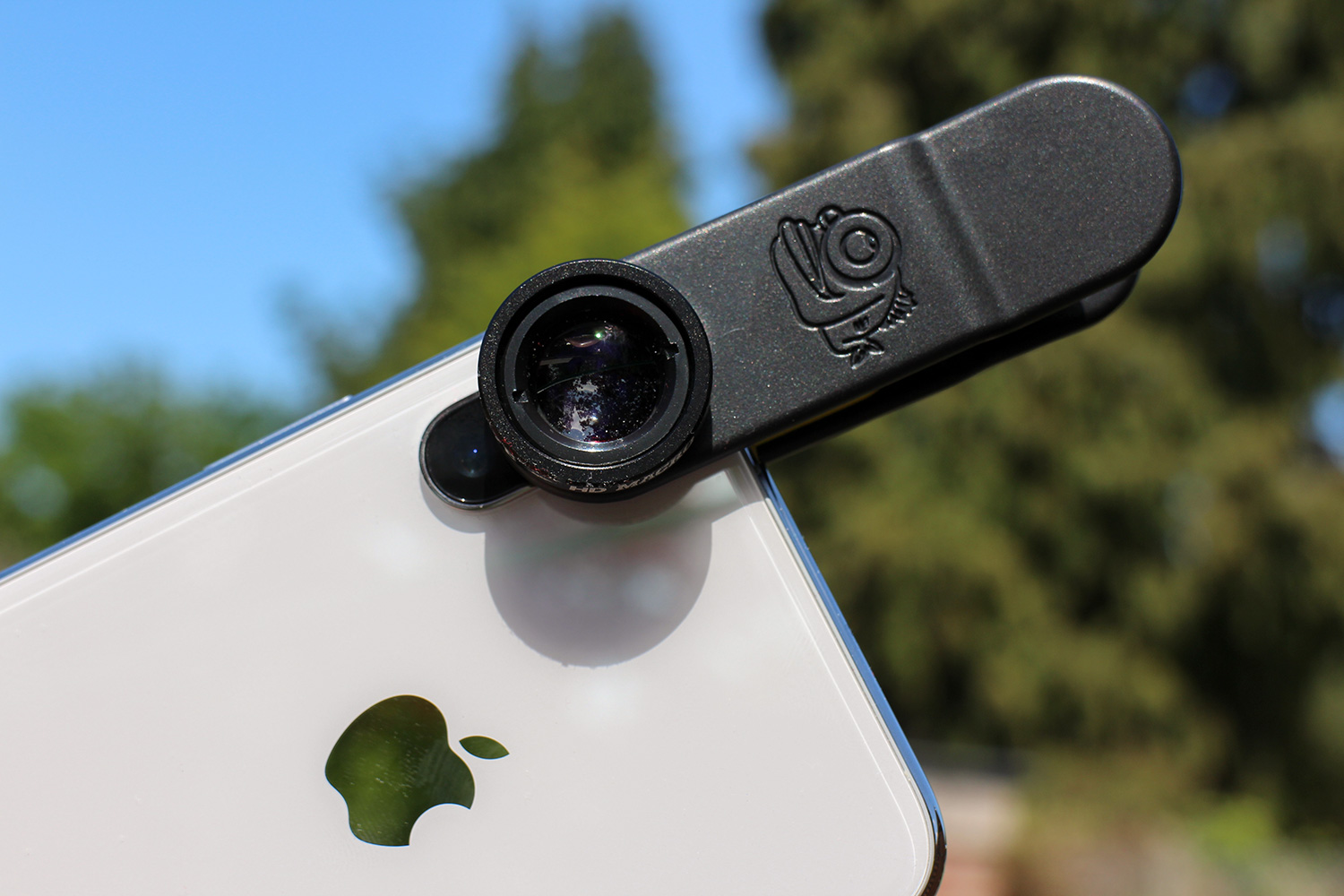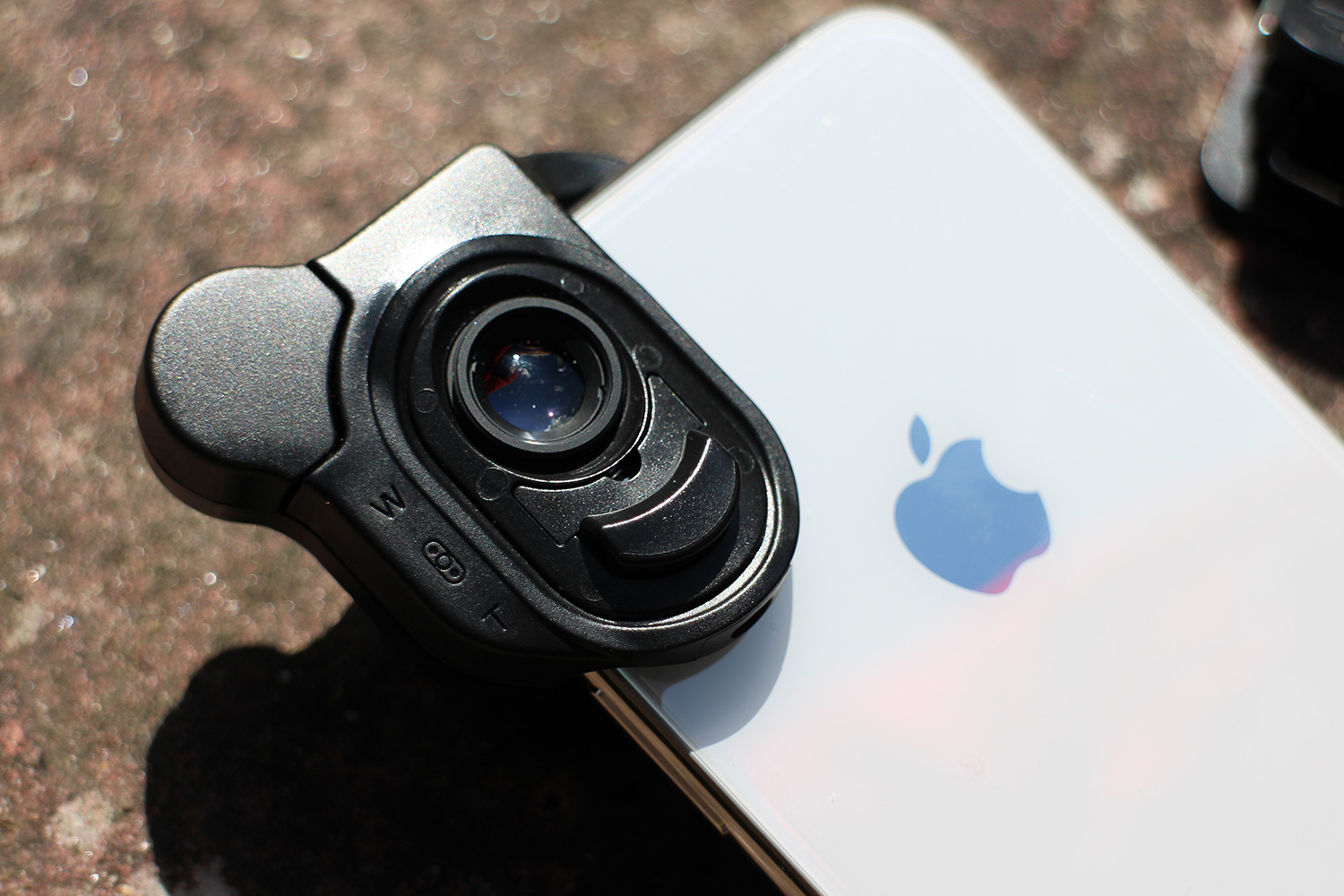Smartphone cameras have telephoto lenses, wide-angle lenses, lenses made for low-light conditions, and even monochrome lenses; but what do you do if macro shots are your thing? Most phones can get close to a subject, just not really close. To do this, you’ll need to buy a special lens attachment, getting you right up close and personal for super detailed macro pictures.
While you’re not stuck for choice, there is a considerable variation in price, from an affordable $20 up to a less affordable $100 or more. Is there a difference, and does spending more mean better macro photos? We’ve attached four macro lenses spanning this price range to the iPhone X to find out, and here are the results.
The lenses
The two cheapest macro lenses come from Aukey, a popular smartphone accessory maker with a massive array of products available on Amazon. The $20 is the cheapest, and has a 10x macro lens attachment. The $30 has a 15x macro lens. Both these kits also come with wide-angle lenses, which we didn’t test in this comparison.
The $42 Black Eye HD Macro lens has a 15x macro magnification, but doesn’t come with any other lenses at this price. Finally, the new $100 Olloclip Connect X system comprises of a 15x macro lens, along with a fisheye and super-wide angle lens, all connected up in a special attachment specially-made for the iPhone X. We’ve taken a look at the complete Olloclip package here. The three other lenses are attached using a spring-loaded clip, and are compatible with a wide variety of phones.
It’s worth noting that the Aukey lenses aren’t really designed for phones with dual-lens cameras, but we didn’t experience major issues using them on the iPhone X — which we used for comparison’s sake, due to the Olloclip’s exclusivity — apart from the occasional bit of light-leak in certain lighting conditions. The Black Eye lens is more compact, and it easily fits over the iPhone X’s camera; it not affected by outside light. All four lenses require any case on the phone to be removed, although it’s possible to buy cases that are compatible with the Olloclip system.
Magnification claims
Three of the four lenses here claim to have a 15x macro magnification, yet all deliver very different photos. The Olloclip’s macro lens requires you to get so close to the subject before it focuses, and creative uses are drastically limited. The Aukey and Black Eye lenses are more versatile, despite having the same magnification as the Olloclip. You’ll see in our example photos how this affects the pictures we took.
Difference in focal distance
- 1. Aukey WD07
- 2. Aukey WD06
- 3. Black Eye HD Macro
- 4. Olloclip Connect X
To illustrate how much variation there is in the distance between lens and subject across the four lenses, here is a photo taken at a fixed distance, starting out with the iPhone X’s camera without a lens, then the 10x Aukey lens, the 15x Aukey lens, the Black Eye lens, and finally the Olloclip lens. It’s the Aukey PL-WD07, which costs $20, which takes the best photo here with it’s 10x macro lens. The 15x macro WD06 manages to focus, but from exactly the same distance, the Black Eye and Olloclip can’t focus at all. This gives you an idea of just how close you need to get before these two lenses will focus on a subject.
While this means you get much more detail close-up images, it does make getting the right picture more of a challenge, as the lens can be almost touching the subject. Not easy if it’s a moving object, or a living creature likely to scurry away.
Tom Ford case
- 1. Aukey WD07
- 2. Aukey WD06
- 3. Black Eye HD Macro
- 4. Olloclip Connect X
For this picture (and each subsequent one from here) we moved closer to the subject until the camera and lens focused. This shows just how close the Olloclip and Black Eye lenses can get, and the amount of detail each one can reveal. First, a photo from the iPhone X without a lens attachment.
The WD07, with the 10x macro, suffers from some light leakage here, but it still focuses on the Tom Ford logo. There is less light leakage on the WD06, and the macro effect is greater. The Black Eye lens gets so close that it’s impossible to fit the entire logo in the frame, but you start to see more tiny details in the image. The Olloclip, however, gets right down to details in the case’s fibers.
Note that in all of the images, there’s considerable vignetting (blurring around the central focal point), which only becomes more obvious as you move through the different lenses. The effect is at its most dramatic on the Olloclip, due to the massive magnification, and can be quite distracting depending on the subject.
Tea leaves
- 1. Aukey WD07
- 2. Aukey WD06
- 3. Black Eye HD Macro
- 4. Olloclip Connect X
Moving onto a subject that favors the lenses that like to get really close, this image shows some tea leaves, focusing in on a cherry blossom leaf. The difference is startling, and the Olloclip isolates the leaf in stunning detail, blurring out the background to the point where it’s difficult to tell what you’re actually seeing. The Aukey lenses avoid this, creating a picture that’s both close-up, and well composed. The Black Eye lens combines the best of both, with a much more intimate look at the leaf, while keeping enough background detail to understand the setting.
The Aukey lenses take pictures you can share instantly, standing out on their own; but they don’t work as well when you zoom in further. Zoom in even closer on the Black Eye and the Olloclip images, and the Black Eye comes out on top again, due to the Olloclip’s very narrow focusing point.
Blossom
- 1. Aukey WD07
- 2. Aukey WD06
- 3. Black Eye HD Macro
- 4. Olloclip Connect X
Macro photography works really well when examining small, natural objects we rarely get a truly close look at. This single blossom is an excellent example, and the picture reveals how sensitive the Olloclip’s lens is to its subject. The Aukey pictures both look great, although the tight focal point means there are parts of the blossom that aren’t in focus, despite being closer to the camera lens. The Black Eye lens has the same issue, but still creates a great photo.
The Olloclip needed to be so close that all sense of what you’re seeing is lost. Light is also cut down, meaning the final picture suffers greatly. There is a better picture in there, which editing does help bring out; but the success of the final image greatly depends on whether the camera managed to focus properly in the first place, which isn’t always easy when working in such close proximity and with such a narrow focal distance.
Dandelion clock
- 1. Aukey WD07
- 2. Aukey WD06
- 3. Black Eye HD Macro
- 4. Olloclip Connect X
A familiar sight in springtime, the Dandelion clock is a work of natural art, and it’s always tempting to get a closer look. Here you can see the vignetting in action on the Aukey and the Black Eye lens, but it doesn’t ruin the picture. Zoom in on all three and you’ll see a considerable amount of detail.
The Olloclip stands apart in that you’re transported inside the clock itself, enveloped by the seeds and their fluffy parachutes. Unrecognizable unless you’re told what it is, the picture borders on the abstract. It’s proof that with the right subject and in the right lighting conditions, the Olloclip can be a very creatively exciting addition to the iPhone X — but you’ll need more photographic skill to recognize and exploit its talent.
Wood
- 1. Aukey WD07
- 2. Aukey WD06
- 3. Black Eye HD Macro
- 4. Olloclip Connect X
This picture shows how creative you can get with macro photography even with everyday objects. This is actually the top of a wooden stake. All four camera lenses take good photos, outside of some annoying vignetting, with the Black Eye taking our favorite. What this photo does is play to the Olloclip’s strengths. It operates best when directly over the top of its subject, and when it doesn’t move.
Stone and needles
- 1. Aukey WD07
- 2. Aukey WD06
- 3. Black Eye HD Macro
- 4. Olloclip Connect X
Our final picture also presents the Olloclip with a stationary subject which can be photographed overhead. It’s very selective with where it will focus too, blurring out everything except one section, which we’d expect to happen with a high-magnification macro lens. The other three lenses are more versatile, with the Aukey WD06 producing a great image that works even better when cropped down. Remember, the WD06 costs $30.
Conclusion
You simply don’t need to spend $100 to take great macro shots with your phone. While spending $20 will get solid results, you can’t get quite close enough to really take an outstanding macro picture; but if that’s your budget then you won’t be as disappointed with the results.
Our recommendation is either the $30 Aukey WD06 or the $42 Black Eye Macro lens. The Aukey WD06 is excellent value considering you also get a wide-angle lens, the macro shots don’t go mad with the vignetting, and can still be cropped for greater impact. The Black Eye lens is only for macro shots, and gets in closer than the Aukey lenses, but not ridiculously so like the Olloclip. It’s the best choice if you’re only looking for a macro lens, and don’t mind spending a little more.
The Olloclip, which is the newest and most expensive lens on test here has its benefits. The fitment is excellent, it has a fish-eye and wide-angle lens included in the price, and the lenses are very high quality. But for macro photography, you’re going to need skill and patience to get a great shot. If you want to take a shareable, eye-catching photo quickly and easily, it’ll prove frustrating.



































